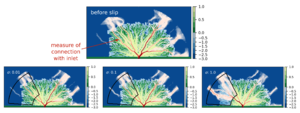Log in (or create account for non-CSDMS members)
Forgot username? Search or email:CSDMSweb@colorado.edu
Browse abstracts
Does faulting-induced subsidence drive distributary network reorganization?
Andrew Moodie, University of Texas at Austin Austin Texas, United States. amoodie@utexas.edu
Paola Passalacqua, University of Texas at Austin Austin Texas, United States.
Deltas exhibit spatially and temporally variable subsidence due, in part, to faulting that lowers the land surface over time, thereby converting subaerial land to open water. In light of expected billion-dollar investments globally to redirect sediment via channel diversions and thus restore delta land, it is crucial to understand whether discrete faulting-induced subsidence events drive distributary channel networks to reorganize. Here, we take inspiration from examples from two deltas of faulting with documented surface expression and with distinct flux-to-shoreline symmetries: the symmetric-flux Selenga River delta (Russia) and the asymmetric-flux Mississippi River delta (Louisiana, USA). Using simulations with the DeltaRCM numerical model resembling these deltaic landscapes, we examine distributary network reorganization to faulting-induced subsidence over a range of surface area and slip displacement. Our findings indicate that in a symmetric-flux delta system, the duration of fault surface expression is strongly and non-linearly related to displacement, because slip above a threshold length-scale drives wholesale channel network reorganization, whereas smaller displacement does not. In contrast, displacement is only weakly related to network reorganization in the asymmetric-flux simulations. In this environment, faults located in areas of the delta not maintaining a surface-water connection to the main channel at the time of the subsidence event do not instigate network reorganization. Moreover, for the range of surface area and slip displacement we examined, areas of faulting also do not significantly influence the distributary network at later times. Nevertheless, all faulting events in simulated deltas, with both symmetric and asymmetric flux, create accommodation space and so inhibit the construction of subaerial land to some degree.


